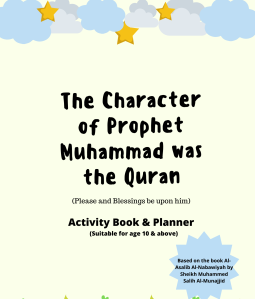Prophet Muhammad (peace and blessing be upon him) is our best teacher. Prophet Muhammad (peace and blessing be upon him) used various effective strategies in teaching and delivering messages to his sahabah. His Sahabah were not only among adults but includes the young ones. There were numerous hadiths recorded about the methods that he used to deliver the message and to teach them.
1. GENTLY RAISE YOUR VOICE AND REPEAT
In teaching, Prophet Muhammad (peace and blessing be upon him) would sometimes raise his voice firmly but in a gentle manner. He repeated the essential points a few times to give emphasis to the message delivered. As narrated by ‘Abdullah bin Amr, “Once the Prophet remained behind us in a journey. He joined us while we were performing ablution, which was overdue. We were just passing wet hands over our feet (and not washing them properly), so the Prophet addressed us in a loud voice and said twice or thrice: “Save your heels from the fire.” [1]
Repeating the key points can help to ensure that we remember the points and appropriately complete the task. Research done by Professor Tsedal B. Neeley from Harvard Business School together with Paul M. Leonardi and Elizabeth M. Gerber from Northwestern University showed that a manager who delivered a message repeatedly helped in assuring the project was completed quickly by his or her teammates.[2]

2. CHOOSE THE RIGHT TIMING
Secondly, Prophet Muhammad (peace and blessing be upon him) would find a suitable time to teach His Sahabah, not to make them feel bored by listening to his teaching all the time. Ibn Masood narrated, “Prophet Muhammad (peace and blessing be upon him) used to take care of us in preaching by selecting suitable time so that we might not get bored. (He abstained from pasturing us with sermons and knowledge all the time).” [3]
Choosing the right timing in delivering messages is important, and this has been supported by a study that was done in 1996, in a journal called ‘The National Teaching & Learning Forum’. It described how research on human attention and retention is affected by long lectures. Optimal focus can only be achieved within 10 to 18 minutes only. [4] If teaching is done continuously without a break in between the time, effective teaching can’t be reached.
3. ASK QUESTION
Other than the methods mentioned above, Prophet Muhammad (peace and blessing be upon him) used to ask a question to the people that he was preaching. For example, Ibn Umar narrated that ‘Prophet Muhammad (peace and blessing be upon him) said, “Amongst the trees, there is a tree, the leaves of which do not fall and is like a Muslim. Tell me the name of that tree.” Everybody started thinking about the trees in the desert areas. And I thought of the date palm tree. The others then asked, “Please inform us what is that tree, O Rasulullah?” He replied, “It is the date palm tree.” [5]
The reason why Prophet Muhammad (peace and blessing be upon him) asked questions was to attract the Sahabahs’ attention and to develop curiosity among them. By allowing the learners to be curious, especially the kids, we recognize their minds to be active instead of passive and observant of new ideas. It also opens up new worlds and possibilities which bring excitement to learners’ life. [6] A study done by Kashdan, Todd B.; Steger, and Michael F showed that curiosity is an ingredient in the development of well-being and meaning in life. [7]
4. USE AN INFOGRAPHIC
Not to forget, in teaching, Prophet Muhammad (peace and blessing be upon him) did also sometimes use an infographic to increase the effectiveness in delivering knowledge. One day, as Prophet Muhammad (peace and blessing be upon him), sat with his companions, he drew a straight line in the dirt. He then drew a series of lines branching off from either side of it. When the companion asked him what it meant, he pointed to the branches and told them that they represented the various path of misguidance in this life. He went on to say that at the head of each path sat a devil inviting people to it. After that, he pointed to the straight line in the middle and told them that it represented the path of ALLAH. He said to them that it was his path and he recited Surah Al-Anaam ayah 153. [8]
By using an infographic, a message can be communicated quickly, and meaningfully and hidden data can be revealed to learners effectively. It is a natural tendency for learners to learn through seeing and interaction. A study showed that the usage of infographics in learning can increase learners’ visual literacy and helps in increasing teaching effectiveness. [9]
Mentioned above are some of the methods used by Prophet Muhammad (peace and blessing be upon him) in teaching. There are many others not mentioned here that are very interesting for us to learn, emulate and practice. His teaching methodology has changed Muslim ummah in general, and his Sahabah specifically from a jahiliya nation into a well-learned, practicing Muslim that has become an excellent example for us today. By following his example and asking Allah’s guidance, insyaAllah we can be great teachers ourselves and can deliver the knowledge effectively to our students. Ameen.
Conclusion
Please find our product, an activity book, to teach our kids and ourselves about the character of Prophet Muhammad (peace & blessings be upon him) here.

Written by Dr. Fadzidah Ariffin UmmAbdullah
[1] The book of knowledge, hadith no 57. Sahih Bukhari
[2] http://hbswk.hbs.edu/item/6629.html
[3] The book of knowledge, hadith no 68. Sahih Bukhari
[4] http://ideas.time.com/2012/10/02/why-lectures-are-ineffective/
[5] The book of knowledge, hadith no 59. Sahih Bukhari
[8] Reported by Ibn Masood and Collected by an-Nasaaee, Ahmad, and ad-Daarimee in Fundamental of Tawheed by Dr. Abu Ameenah Bilal Philip.
[9] http://www.beds.ac.uk/jpd/volume-4-issue-2/teaching-with-infographics
http://psychcentral.com/blog/archives/2015/05/26/the-importance-of-developing-curiosity/
http://blog.visual.ly/how-to-turn-infographics-into-effective-teaching-tools/ http://www.educatorstechnology.com/2013/02/ways-to-teach-using-infographics.html
Bibliography:
• The book of knowledge, Sahih Bukhari
• http://hbswk.hbs.edu/item/6629.html
• http://ideas.time.com/2012/10/02/why-lectures-are-ineffective/
• Fundamental of Tawheed by Dr. Abu Ameenah Bilal Philip.
• http://www.beds.ac.uk/jpd/volume-4-issue-2/teaching-with-infographics
• http://psychcentral.com/blog/archives/2015/05/26/the-importance-of-developing-curiosity/
• http://blog.visual.ly/how-to-turn-infographics-into-effective-teaching-tools/ http://www.educatorstechnology.com/2013/02/ways-to-teach-using-infographics.html
[…] Read about other prominent Islamic figures here. […]
LikeLike
For my thesis, I consulted a lot of information, read your article made me feel a lot, benefited me a lot from it, thank you for your help. Thanks!
LikeLike